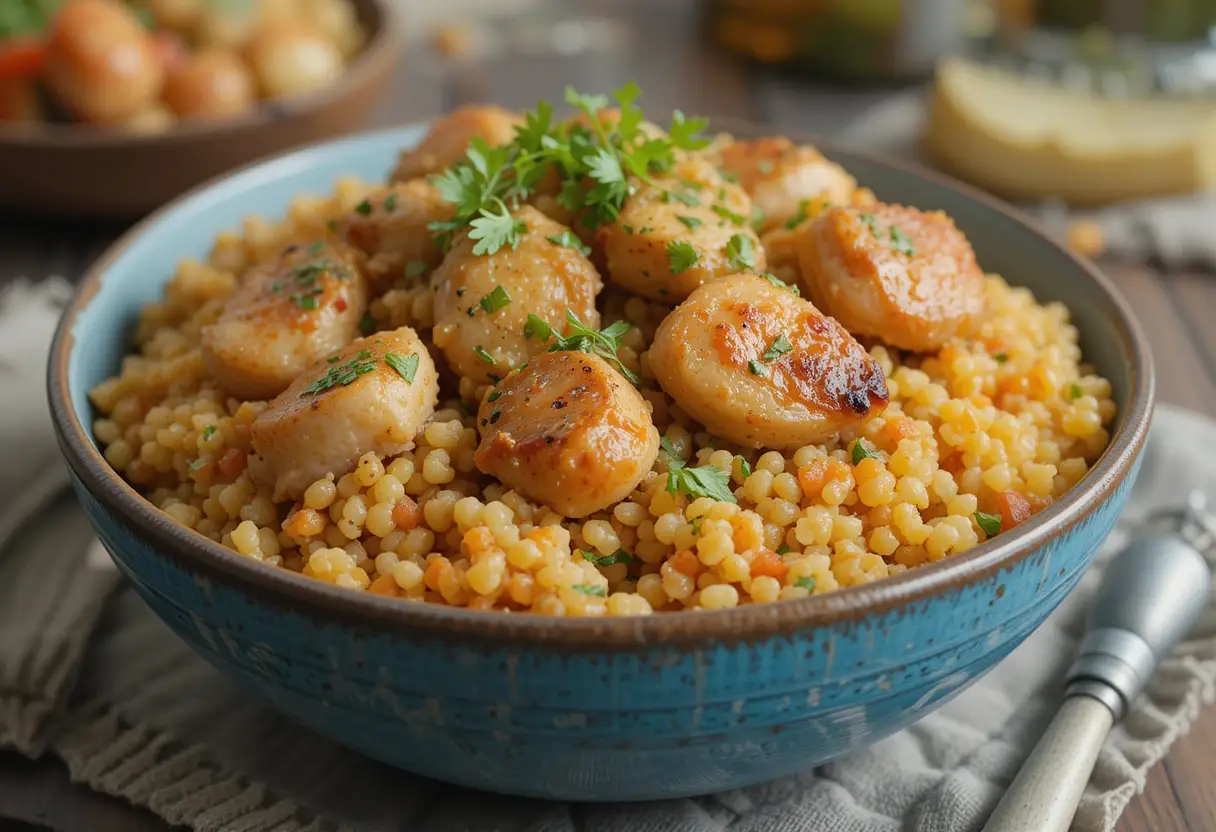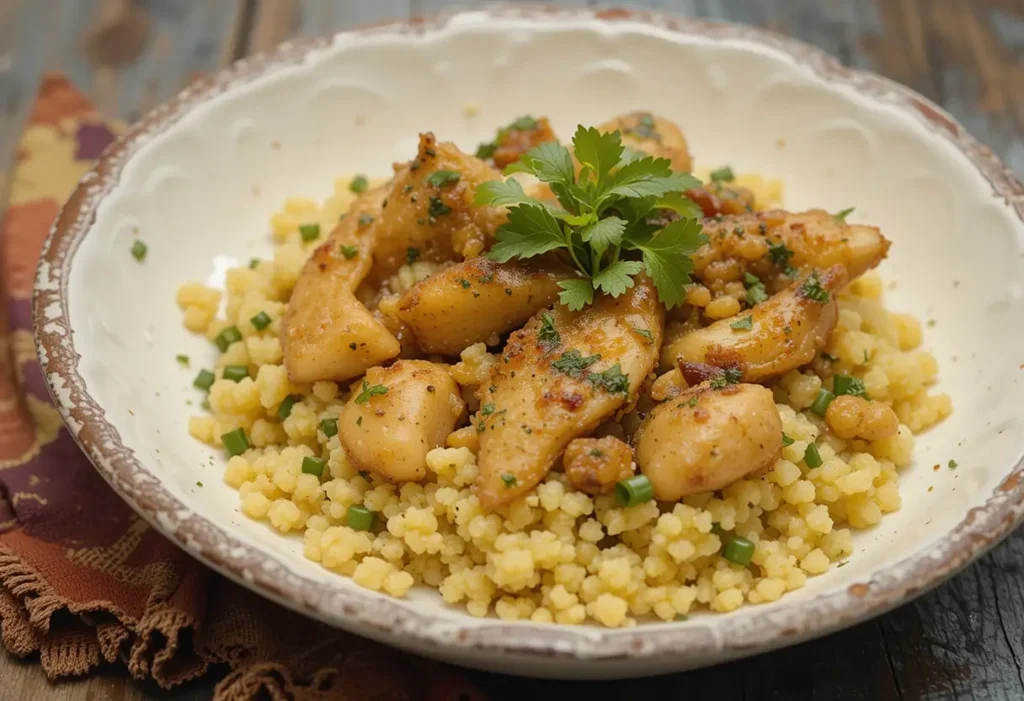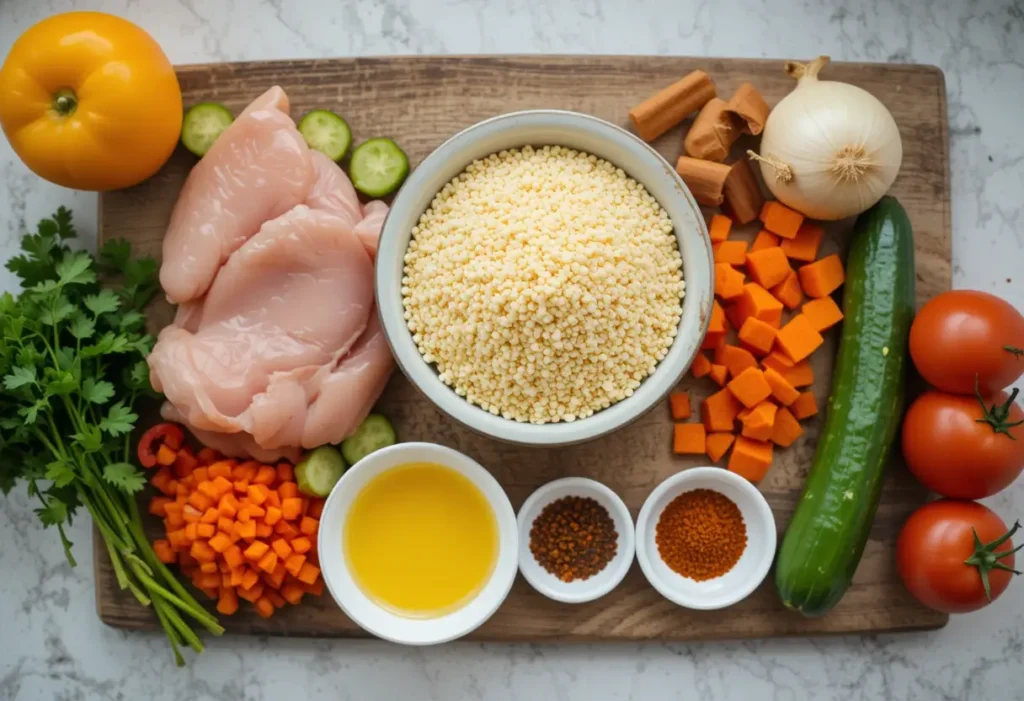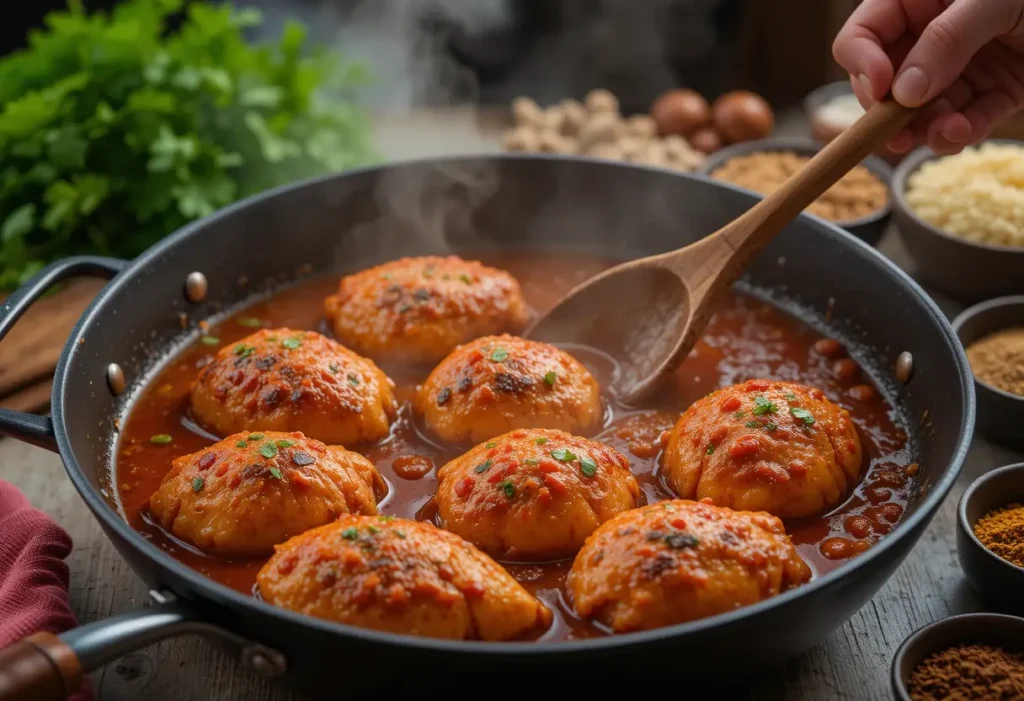Chicken Couscous is a delightful dish that combines tender chicken pieces with couscous, a type of steamed semolina granules. This dish is versatile, nutritious, and widely cherished across many cultures. Known for its hearty flavors and ability to be adapted with various ingredients, Chicken Couscous has become a staple in both traditional and modern cuisine.
Table of Contents
Historical Background of Couscous
Couscous has its roots in North Africa, particularly among Berber communities. It is one of the oldest forms of pasta, dating back to at least the 13th century. Traditionally, couscous was made by hand, rolling semolina with water to create small granules. Over time, it spread across the Mediterranean, Europe, and the Middle East, evolving in preparation methods and accompaniments.
Chicken Couscous emerged as a popular variation, particularly in regions where chicken is more readily available. The fusion of couscous with chicken reflects a blend of practicality and culinary innovation, adapting this traditional dish to meet local tastes and ingredients.
Chicken Couscous in Different Cultures
Chicken Couscous holds a special place in many cultures. For the Moroccan, it is often served during family gatherings and festive occasions, enriched with a medley of vegetables and fragrant spices like saffron and cinnamon. In Algeria and Tunisia, chicken couscous is a weekly staple, often enjoyed on Fridays as part of a communal meal.
For the Mediterranean cuisine, Chicken Couscous is paired with olive oil, fresh herbs, and lemon, offering a lighter, refreshing take. In modern Western interpretations, it may be enhanced with grilled vegetables, nuts, and dried fruits, showcasing its adaptability and universal appeal.
Nutritional Value of Chicken Couscous
Key Ingredients and Their Benefits
Chicken Couscous is not only delicious but also nutritious. The key ingredients include:
- Chicken: A high-protein, low-fat source of essential nutrients such as niacin, selenium, and B vitamins, supporting muscle repair and overall health.
- Couscous: Rich in carbohydrates, couscous provides energy while being low in fat. Whole wheat couscous adds dietary fiber, promoting digestion.
- Vegetables: Commonly used vegetables like carrots, zucchini, and bell peppers are rich in vitamins, antioxidants, and minerals.
- Spices: Ingredients like turmeric, cumin, and coriander offer anti-inflammatory properties and enhance metabolic health.
Caloric Content and Health Considerations
The caloric content of Chicken Couscous varies depending on the preparation and portion size. On average:
- A serving of Chicken Couscous (1 cup) contains approximately 300–400 calories.
- It is low in saturated fats, making it heart healthy.
- The dish can be modified to meet dietary preferences by using lean chicken cuts, reducing oil, or substituting traditional couscous with whole grain alternatives.
Chicken Couscous is an excellent choice for balanced meals, offering a harmonious blend of protein, fiber, and complex carbohydrates. With mindful preparation, it can suit various dietary needs, from weight management to muscle building.
Preparing Chicken Couscous
Essential Ingredients for Chicken Couscous
To prepare a delicious Chicken Couscous, the following ingredients are typically required. Quantities may vary based on servings:
- Couscous (2 cups): Choose between regular, whole wheat, or pearl couscous depending on preference.
- Chicken (500g or 1 lb): Boneless, skinless chicken thighs or breasts work well for this dish.
- Vegetables:
- Carrots (2 medium, sliced)
- Zucchini (1 medium, diced)
- Bell peppers (1 cup, diced)
- Onions (1 large, finely chopped)
- Tomatoes (2 medium, chopped)
- Chicken Stock (2 cups): Provides a rich base for the couscous.
- Spices:
- Turmeric (1 tsp)
- Cumin (1 tsp)
- Paprika (1 tsp)
- Cinnamon (1/2 tsp)
- Herbs: Fresh parsley or cilantro (1/4 cup, chopped).
- Olive Oil (3 tbsp): Used for sautéing and drizzling.
- Optional Garnishes: Dried fruits (raisins or apricots), nuts (almonds or pine nuts), or lemon wedges.
Best Types of Couscous for the Dish
- Traditional Couscous: Fine-grained and quick to cook; ideal for soaking up flavors.
- Whole Wheat Couscous: A healthier, fiber-rich option for a nutty taste.
- Pearl Couscous (Israeli Couscous): Larger and chewier, great for a modern twist.
Recommended Chicken Cuts
- Boneless, Skinless Thighs: Juicy and flavorful, perfect for slow cooking or stewing.
- Chicken Breasts: Lean and tender, ideal for a lighter version of the dish.
- Bone-In Cuts: Add depth of flavor when stewed, though they require longer cooking times.
Step-by-Step Cooking Guide
Basic Preparation Techniques
- Prepare the Couscous:
- Boil 2 cups of chicken stock with a pinch of salt and a drizzle of olive oil.
- Remove from heat, stir in 2 cups of couscous, cover, and let it steam for 5 minutes.
- Fluff with a fork before serving.
- Marinate the Chicken:
- Mix turmeric, cumin, paprika, and a pinch of salt in a bowl.
- Rub the spice mixture onto the chicken pieces.
- Let it marinate for 15–30 minutes to infuse flavor.
- Sauté Vegetables:
- Heat olive oil in a large pan over medium heat.
- Add onions and cook until translucent.
- Stir in the chopped vegetables, cooking until they soften.
- Cook the Chicken:
- In the same pan, sear the marinated chicken on both sides until golden brown.
- Add tomatoes and additional chicken stock, allowing it to simmer until the chicken is fully cooked.
- Combine and Serve:
- Layer the couscous on a serving plate.
- Arrange the chicken and vegetables on top.
- Garnish with fresh herbs, dried fruits, or nuts as desired.
Advanced Cooking Tips for Enhanced Flavor
- Toast the Couscous: Before steaming, lightly toast the couscous in a dry pan to enhance its nutty flavor.
- Use a Tagine: Cooking in a traditional tagine helps retain moisture and meld flavors.
- Add Aromatics: Include garlic, ginger, or a bay leaf for an extra depth of flavor.
- Caramelize the Onions: Slowly caramelize onions before adding other vegetables for a sweet, rich base.
- Finish with a Citrus Zest: Grate lemon or orange zest over the dish before serving for a bright, fresh note.
By following these steps and tips, you can craft a Chicken Couscous dish that is both authentic and customizable, making it a highlight of your culinary repertoire.
Serving and Pairing Ideas
Best Side Dishes to Complement Chicken Couscous
Vegetable Pairings
- Roasted Vegetables: Carrots, zucchini, eggplant, and bell peppers roasted with olive oil and herbs provide a flavorful complement.
- Steamed Greens: Spinach, kale, or Swiss chard add a nutritious balance to the dish.
- Salads: A light Mediterranean salad with cucumber, tomato, and feta cheese dressed in olive oil and lemon works well.
Appropriate Sauces and Condiments
- Harissa: A spicy North African chili paste that adds heat and depth.
- Yogurt Sauce: A cooling side made with yogurt, garlic, and mint.
- Preserved Lemon: A tangy condiment that enhances the dish’s citrusy notes.
Non-Alcoholic Beverages
- Mint Tea: A classic choice in North African cuisine, offering a refreshing balance.
- Citrus-Infused Water: Lemon or orange slices in chilled water enhance the dish’s zestiness.
- Sparkling Water: A bubbly, neutral option that cleanses the palate.
Storing and Reheating
Best Practices for Storage
Refrigeration Tips
- Cool the Dish: Let the chicken couscous cool to room temperature before storing.
- Airtight Containers: Use airtight containers to prevent moisture loss and maintain freshness.
- Storage Duration: Keep in the refrigerator for up to 3 days.
Freezing Techniques
- Separate Components: Freeze the couscous and chicken separately for better texture retention.
- Portion Control: Divide into meal-sized portions to simplify reheating.
- Proper Wrapping: Use freezer safe containers or bags to prevent freezer burn.
- Shelf Life: Store in the freezer for up to 3 months.
Reheating Without Losing Flavor
Microwave vs. Oven Reheating
- Microwave:
- Add a splash of water or chicken stock to keep the dish moist.
- Cover with a microwave safe lid or wrap to avoid drying out.
- Heat in intervals, stirring occasionally for even warming.
- Oven:
- Preheat the oven to 350°F (175°C).
- Place the dish in an oven safe container, cover with foil, and reheat for 15–20 minutes.
- Add a drizzle of olive oil or chicken stock to refresh flavors.
Health and Dietary Considerations
Is Chicken Couscous Good for Weight Loss?
Analyzing Caloric Impact
Chicken couscous is moderate in calories, with approximately 300–400 calories per serving. Its combination of lean protein and whole grain couscous can support weight loss by promoting satiety. Using low-oil cooking methods and portion control can further enhance its suitability for a calorie conscious diet.
Dietary Fiber Content and Its Effects
- Whole Wheat Couscous: A rich source of dietary fiber, aiding digestion and keeping you full for longer.
- Vegetables: Adding fiber rich vegetables like zucchini and carrots boosts the dish’s nutritional profile and helps regulate blood sugar levels.
Allergy Information and Substitutions
Common Allergens in Couscous
- Wheat: Traditional couscous contains gluten, which can trigger reactions in individuals with gluten intolerance or celiac disease.
- Spices: Some spice blends may contain allergens or additives.
Safe Substitutes for Allergy Sufferers
- Gluten-Free Couscous Alternatives:
- Quinoa: A protein rich, gluten free substitute with a similar texture.
- Millet or Rice: Simple grain alternatives for those avoiding gluten.
- Herb and Spice Adjustments: Replace premixed spice blends with single ingredient, allergen free options.
- Vegetarian or Vegan Options: Substitute chicken with chickpeas or tofu for a plant-based version.
By following these serving, storage, and dietary recommendations, you can create a versatile Chicken Couscous dish that meets diverse preferences and retains its flavor across multiple meals.
FAQs About Chicken Couscous
How Long Can You Store Cooked Chicken Couscous?
Cooked Chicken Couscous can be stored safely in the refrigerator for up to 3 days if kept in an airtight container. To extend its shelf life, freeze it for up to 3 months. Ensure that the dish is fully cooled before refrigerating or freezing to prevent condensation, which can affect texture and flavor.
Can Chicken Couscous Be Made in a Slow Cooker?
Yes, Chicken Couscous can be adapted for a slow cooker. Here’s how:
- Layer Ingredients: Add vegetables, chicken, spices, and chicken stock to the slow cooker.
- Cook Low and Slow: Set the cooker to low for 6–8 hours or high for 3–4 hours.
- Prepare Couscous Separately: Cook couscous on the stovetop or by steaming, and mix it with the slow cooked chicken and vegetables before serving. This prevents the couscous from becoming mushy.
Are There Any Nut-Free Variants of Chicken Couscous?
Yes, Chicken Couscous can be made nut free by:
- Omitting Garnishes: Avoid topping with almonds, pine nuts, or other nuts.
- Using Safe Spices: Ensure spice blends do not contain traces of nuts.
- Adding Substitutes: Use seeds like sunflower or pumpkin seeds for texture, or skip garnishes entirely.
Always check labels if preparing for someone with severe nut allergies.
What Are the Best Spices to Use in Chicken Couscous?
The best spices for Chicken Couscous depend on the flavor profile you want to achieve. Commonly used spices include:
- Traditional North African Flavors:
- Cumin
- Coriander
- Turmeric
- Paprika
- Cinnamon
- Mediterranean Touch:
- Garlic powder
- Oregano
- Thyme
- Lemon zest
- For Heat Lovers:
- Harissa
- Chili flakes
- Smoked paprika
Experiment with blends to match your taste preferences.
How Can I Make Chicken Couscous More Kid-Friendly?
To make Chicken Couscous appealing to children:
- Mild Spices: Reduce the amount of chili or intense spices, using milder seasonings like turmeric or a dash of cinnamon.
- Cut Ingredients Small: Dice vegetables and chicken into bite-sized pieces for easier eating.
- Add Sweetness: Incorporate dried fruits like raisins or apricots to balance flavors.
- Customizable Toppings: Allow kids to add their favorite toppings, such as grated cheese or a dollop of plain yogurt.
- Use Fun Shapes: Substitute regular couscous with pearl couscous, which has a larger, pasta-like texture that many kids enjoy.
Conclusion
Chicken Couscous is more than just a meal—it’s a celebration of flavors, textures, and traditions. Whether you’re looking for a weeknight dinner solution or a dish to impress at gatherings, Chicken Couscous offers a balanced and customizable option. By exploring variations, cooking techniques, and pairing ideas, you can tailor this dish to suit any occasion or dietary need.
For those who enjoy trying other chicken dishes, consider checking out Mini Chicken Pot Pies, which make an excellent appetizer or side. If you’re inspired by North African flavors, Discovering the Delights of Chicken with Peanut Butter might be another intriguing option. For family-friendly meals, you might also explore The Ultimate Guide to Cooking Chicken and Yellow Rice.




